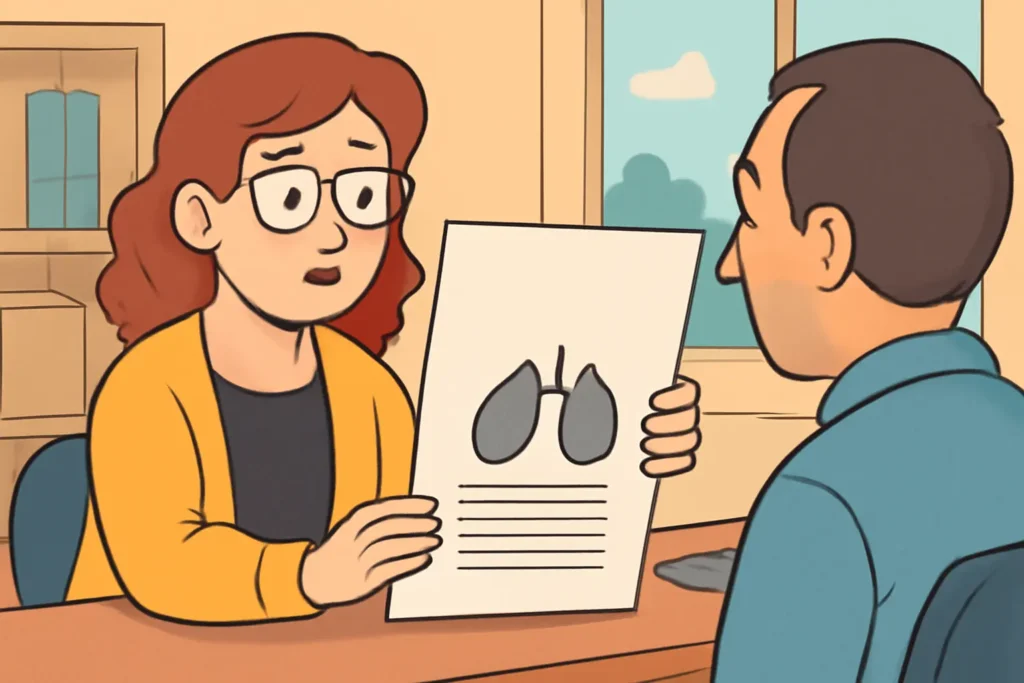Work-related dust diseases represent some of the most challenging occupational health conditions to assess and compensate fairly. These respiratory conditions, including mesothelioma, silicosis, and asbestosis, often develop years or decades after initial exposure, making it difficult to determine their precise impact on an individual’s daily functioning and care needs.
Medico legal reports play a crucial role in accurately documenting the functional limitations and care requirements of workers affected by dust diseases, providing essential evidence for compensation claims and legal proceedings. Our occupational therapy assessments focus on evaluating how these conditions affect a person’s ability to perform daily activities, their need for assistance, and the progression of their symptoms over time.
Understanding the complexities of dust disease assessment requires expertise in both respiratory conditions and legal reporting standards. We examine the unique challenges these diseases present, and distinguish between pre-existing conditions and compensable injuries as well as projecting future care needs as the disease progresses.
Understanding Work-Related Dust Diseases
Definition and Scope of Dust Diseases
Dust diseases are a class of conditions caused by inhaling harmful particles when they are in powder or dust form. In most instances these diseases develop when microscopic particles become lodged in lung tissue (such as with silicosis and asbestosis). In the case of mesothelioma, the harmful dust particles lodge in the mesothelial lining of the lung and chest cavity, or in the lining of the abdomen; and in rare cases in the lining of the testes or heart.
The severity and progression vary significantly between different types of dust diseases. Some conditions like asbestosis develop gradually over decades, whilst others like acute silicosis can progress rapidly with heavy exposure.
Common Types of Occupational Dust Diseases
Asbestosis results from inhaling asbestos fibres, causing progressive lung scarring and pleural thickening. Workers in construction, shipbuilding, and mining face the highest exposure risks.
Mesothelioma is a malignant cancer affecting the mesothelial lining of organs. Pleural mesothelioma (majority of cases) affects lung lining, whilst peritoneal mesothelioma (less common) affects abdominal lining.
Silicosis develops from crystalline silica dust exposure. This mineral appears in soil, sand, natural rocks, and engineered stone products used in construction.
Coal Worker’s Pneumoconiosis, commonly called black lung disease, affects miners exposed to coal dust particles.
Byssinosis occurs in textile workers exposed to cotton, flax, or hemp dust.
Berylliosis results from beryllium exposure in aerospace, electronics, and nuclear industries.
Each condition presents distinct symptoms and progression patterns. Occupational therapy assessments must account for these differences when evaluating functional impacts and care requirements.
Key Risk Factors and Workplace Exposures
Primary exposure occurs in specific industries:
| Industry | Primary Dust Types | Common Diseases |
| Construction | Silica, asbestos | Silicosis, asbestosis |
| Mining | Coal, silica | Black lung, silicosis |
| Shipbuilding | Asbestos | Asbestosis, Mesothelioma |
| Manufacturing | Various minerals | Multiple conditions |
Many workers experience cumulative exposure across multiple job sites and decades of employment. Construction workers may encounter both asbestos in older buildings and silica dust from cutting engineered stone.
Secondary exposure can affect family members through contaminated work clothing and equipment brought home. We assess these exposure pathways when evaluating compensation claims.
Modern workplace safety regulations aim to prevent new cases, but the long latency periods mean workers continue developing diseases from historical exposures.
Medico Legal Reporting in Dust Disease Cases
Medico legal reports form the foundation of successful dust disease compensation claims by establishing the direct link between occupational exposure and current functional limitations. We assess how conditions such as mesothelioma, asbestosis, and silicosis impact a claimant’s ability to perform daily activities and work-related tasks.
Our reports provide courts and tribunals with objective evidence of:
- Current functional capacity and limitations
- Past gratuitous care provided by family members
- Future care requirements as the disease progresses
- Equipment and modification needs
The assessment process involves detailed interviews with claimants and their support networks. We examine how symptoms like dyspnoea, persistent cough, and chest pain affect mobility, self-care, and domestic activities.
Our reports also distinguish between pre-existing conditions and compensable dust disease impacts. For instance, when a claimant has both emphysema and newly diagnosed mesothelioma, we clearly define which functional limitations relate to each condition.
Essential Elements of a Medico Legal Report
A comprehensive dust disease medico legal report contains specific components that ensure thorough evaluation and legal validity. We structure our reports to include detailed symptom assessment, functional analysis, and evidence-based recommendations.
Key report elements include:
| Component | Description |
| Medical History | Complete symptom timeline |
| Functional Assessment | Current capacity for work, domestic, and self-care tasks |
| Care Analysis | Past and future gratuitous or commercial care requirements |
| Equipment Needs | Assistive devices and home modifications |
We conduct thorough interviews to understand symptom progression and its impact on daily functioning. Our assessments examine how dust diseases affect breathing capacity, energy levels, and physical endurance. Medical evidence and specialist medical opinions are considered when determining the future care duration for each claimant.
Each assessment considers the specific dust disease type and prognosis. Mesothelioma cases require different considerations than silicosis due to varying symptom patterns and disease progression.
Importance of Accurate Documentation
Our documentation process involves reviewing comprehensive medical records, including respiratory function tests, imaging results, and specialist reports. We correlate all functional findings from our assessment process with confirmed medical diagnoses and supporting evidence to ensure consistency between reported symptoms and objective medical findings.
Documentation standards include:
- Detailed symptom correlation with medical evidence
- Precise functional capacity measurements
- Clear differentiation between compensable and non-compensable conditions
- Comprehensive care requirement analysis
We maintain detailed records of all assessment procedures and observations. This thorough documentation supports the validity of our findings and recommendations.
The accuracy of our reports depends on understanding each dust disease’s specific characteristics. Asbestosis typically shows gradual progression, while mesothelioma may present with rapid functional decline.
We critically analyse all information provided by claimants and medical practitioners. Our objective approach ensures that our reports provide balanced assessments that accurately reflect the true impact of occupational dust exposure on functional capacity and care requirements.
Need a Dust Disease OT Medico Legal Report? Contact Us Today
At Independent OT Medico Legal we provide comprehensive occupational therapy assessments for dust disease cases across Perth and the rest of Australia. Our expert team understands the complex nature of conditions like mesothelioma, asbestosis, silicosis, and coal worker’s pneumoconiosis.
Our reports support workers’ compensation claims, personal injury cases, and class action proceedings and will provide expert testimony when required.
Contact us today to discuss your dust disease case requirements. Our Perth-based team offers flexible assessment options including home visits for clients with severe respiratory limitations; and videolink consultations if required for more remote areas. We understand the urgency of these cases and work efficiently to provide timely, comprehensive reports that support fair compensation outcomes.
Further Reading
How to Prepare for a Medico-Legal Examination
The Role of Occupational Therapy in Brain Injury Medico-Legal Reports
Determining the Functional Impact of Motor Vehicle Accidents with OT Assessments





